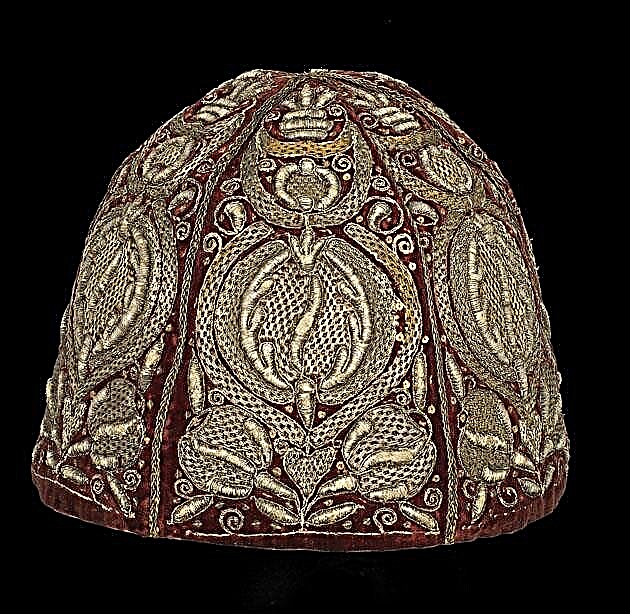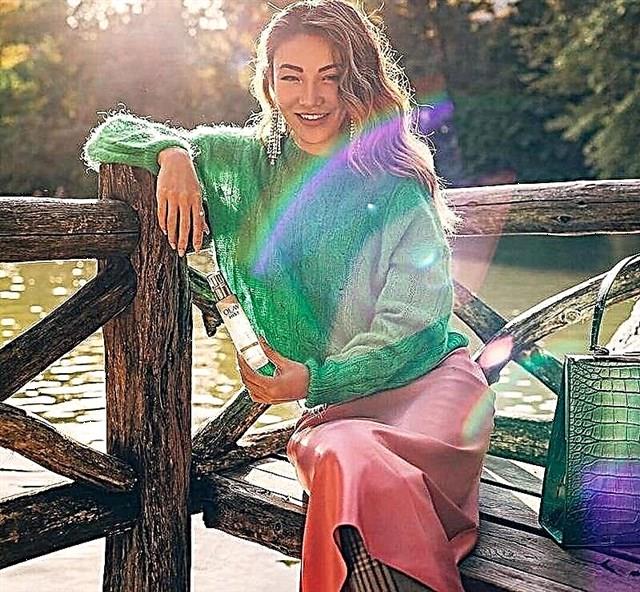Initially, this type of embroidery was truly precious - it was performed in gold and silver. Today they use metallized threads and cord, silk, "iris" - the result still looks luxurious.
Precious sewing: history
Gold, or gold, sewing is a special technique of hand embroidery, known since antiquity. As a rule, metallized gold and silver threads, gimp (a very thin metal thread for embroidery), tweezers (faceted metal thread from a flat section, twisted into a pentagonal spiral), as well as pearls, beads, sequins, are used for gold sewing.
Photo: hands-across-the-sea-samplers.com
The very first information about gold embroidery dates back to the 2nd century BC. e. - according to legend, it arose in the kingdom of Pergamum (northwest of Asia Minor) and from there it came to the Romans. In Russia, mentions of gold embroidery art are found in chronicles, ancient documents, as well as in reviews of foreign travelers, starting from the XI century.
Photo: honorbeforevictory.com
Different types of threads for this type of sewing were made of gold and silver. The metal was made into a very thin wire, which was spirally twisted around linen or silk threads, or used directly by the wire itself for sewing. They embroidered on expensive dense fabrics: taffeta, satin, brocade, velvet, as well as suede and leather, decorated with pearls and gems. It is clear that both the materials for work and the finished products were very expensive. Works preserved from the 15th century are primarily church supplies, icons, embroidered iconostases, banners, banners.
Photo: jessicagrimm.com
The metal thread turned out to be quite brittle, it was difficult to embroider it, like ordinary threads, threading through a fabric. Therefore, the thread was laid on the front side of the fabric in a pattern and attached with silk thread - either in the color of the metal, or in contrast. It turned out real embroidered paintings, either shining monochrome, or multi-colored, colorful.
Photo: sarahhomfray.com
Photo: potos.miarroba.com
22 rare and unusual types of needlework
Gold sewing today
Today, gold embroidery to a large extent has become a secular type of needlework. Workshops of such sewing have been preserved (and are being reborn) at monasteries, but it is increasingly being used for decorating clothes and accessories, creating jewelry, paintings, decorating, and so on.
Photo: kathleenlaurelsage.co.uk
Photo: @nazarkinamasha
For the most part, now with gold embroidery not “precious” ones are used, but metallized, factory-made threads. By the way, instead of gold, this type of sewing began to be called precisely because of the replacement of real gold threads with "gold" threads. Modern threads are no longer as fragile as many centuries ago, but one of the main techniques remains the same: the main thread (cord) is laid according to the pattern and grabbed by a thinner auxiliary thread. To make the pattern voluminous, a substrate of thin cardboard, cloth, leather, rope is placed under a metallized thread. Embroidered with pearls, beads, glass beads, beads, sequins, even buttons.
Photo: @ submarina707
Photo: imperiya. by
I must say that the ability to sew with gold in former times was valued very dearly - in many ways this type of needlework borders on art, in addition, it requires great attention, perseverance, accuracy. And today, gold embroidery is one of the most labor-intensive types of needlework. To reach the heights of excellence, they study him from several weeks to several years in courses, in special schools and even in universities.But to master the basics of this art, sufficient to create and decorate things, you can do it yourself.
Photo: @juliet_mikecharlie
Photo: @ submarina707
White embroidery and Richelieu: a master class for beginners
Gold sewing: learning the basics
You will need:
Photo: @ submarina707
1. Fabric
Start learning better on dense linen or cotton.
2. The hoop
For gold embroidery, rectangular hoops are used - it is necessary that the fabric is stretched over them well and evenly. Ideally, an embroidery machine is suitable - a rectangular design, which has a speckled fabric at some distance from the table: this way the hands get simultaneous access to the front and back sides of the embroidery, this is important for gold sewing. Option - a wooden frame on which the fabric is stretched (you can order one in the art workshop or pull the fabric yourself using the buttons).
3. Threads:
- twisted embroidery thread - iris, silk garus, stitch silk, etc .;
- gold thread - metallized thread or thin metallized lace;
- auxiliary thread - strong silk, cotton, synthetic thread.
4. Material for creating volume, or for flooring
To make the embroidery convex, specially cut pieces of cardboard, cloth, drape, and leather are placed under the threads. For thin volumetric parts, pieces of rope, twine, bundles of floss are suitable. Sometimes, after creating the volume, the embossed pattern is covered with cotton knitwear (optional, but this method allows you to sew more cleanly later).
5. Needles
Embroidery needles No. 1-2, a needle for fine silk with a small eye, a large needle, needles for beads (if you plan to decorate them with embroidery).
6. Materials for decoration
Beads, beads, sequins and so on.
7. Common and auxiliary embroidery tools
Scissors, a knife, a thimble, a pencil / felt-tip pen for applying a pattern to the fabric, wax (to help the threads slip better), fabric glue, coils (a special flat or square reel on which the thread is wound - it is convenient to lay such a coil on the work plane).
Work sequence
1. Decide on the pattern and size of the embroidery. Pick up the fabric, the main ones (wrap them on coils) and auxiliary threads, materials for decoration.
2. Pull the hoop or subframe. The sequence of pulling the edges is in the picture.
3. Apply the pattern to the fabric.
4. If you will be embossing, or tall, embroidery, prepare the backing: translate the pattern of future convex parts of the pattern onto cardboard (cloth, drape), cut out, gently glue the backing to the fabric for embroidery or sew with several stitches. Also, the volume can be created using a rope laid in a pattern and attached to the fabric with several stitches.
5. The embroidery process itself follows. There are a lot of stitches and embroidery methods in gold embroidery. To your attention - three videos explaining the basic principles.
Attach seam:
Floor embroidery:
Cardboard (backing) embroidery:



